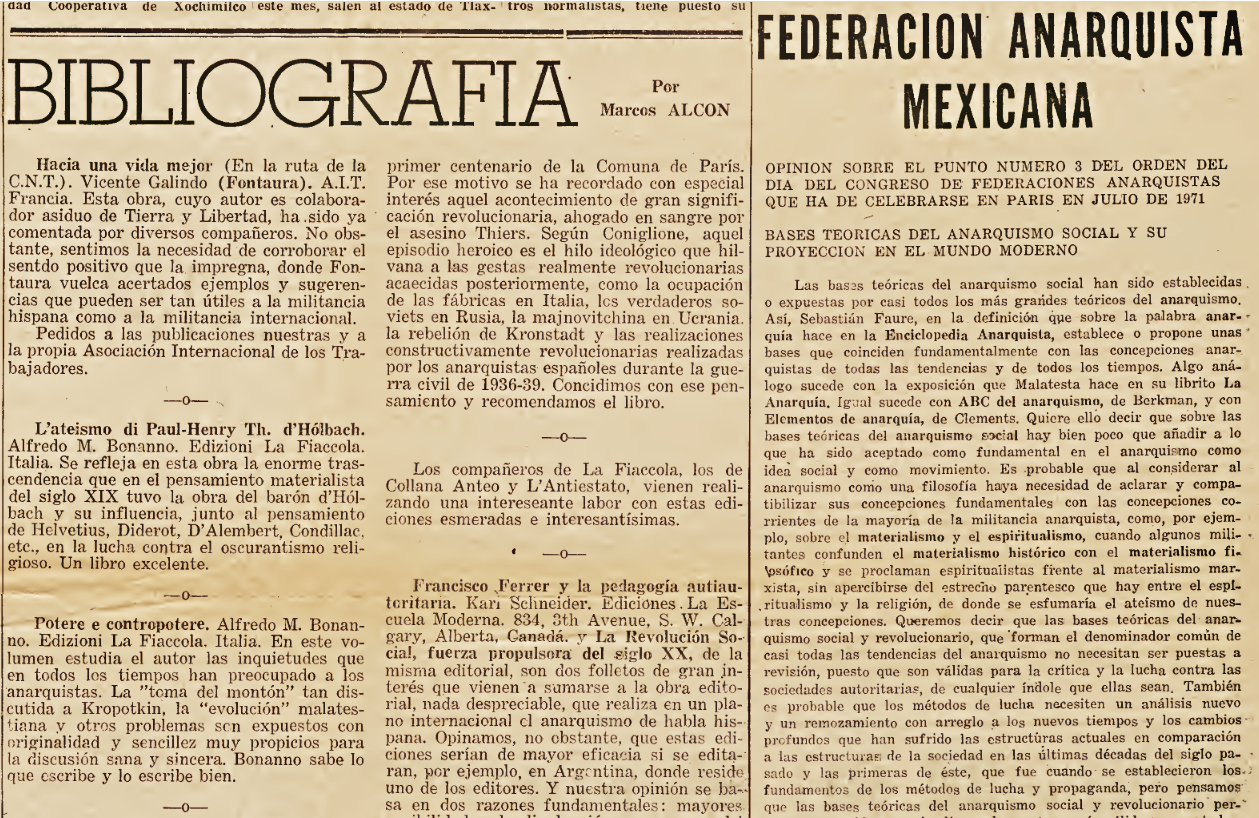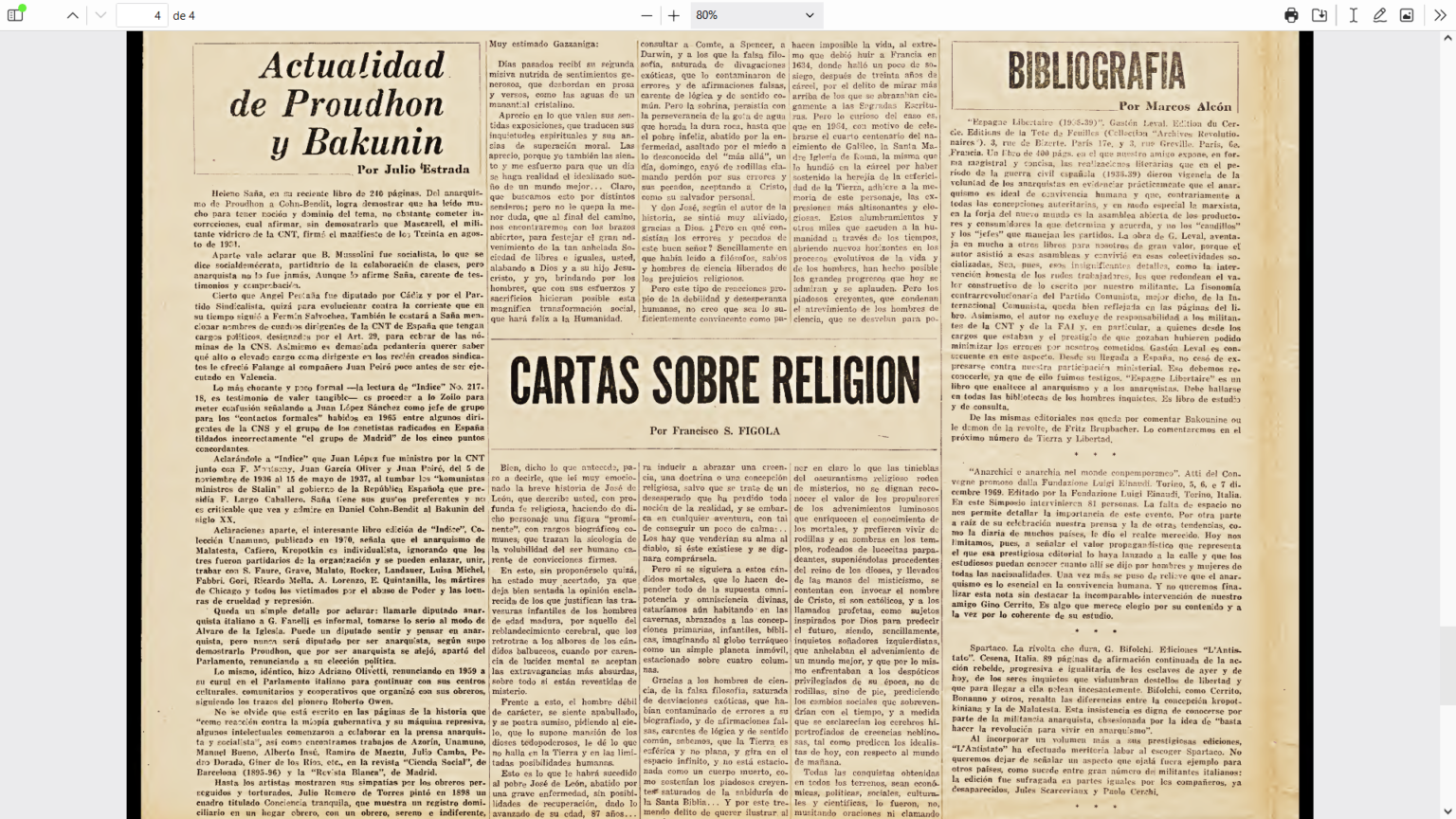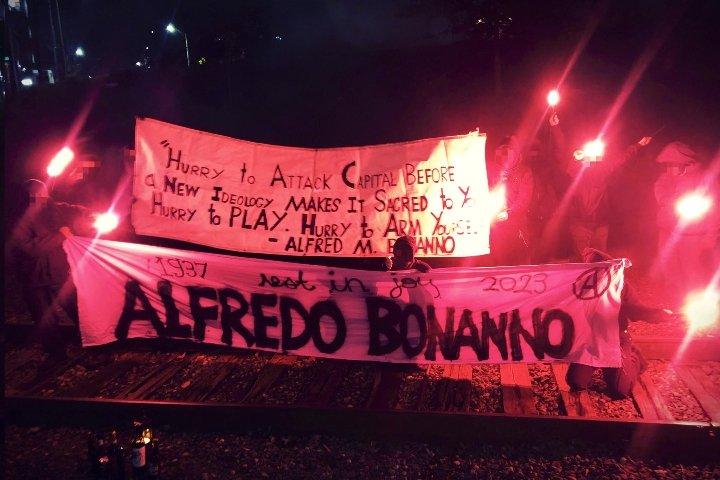In memory of Alfredo M. Bonanno
(Catania 04/Mar/1937 – Trieste 06/Dec/2023)
…no one is totally the fruit of himself and each person, individual, it is certain that he is within a framework of relationships that can provoke him and affect his reactions, emotions and even the logic brought to that point.
– Antonio Lombardo
Before I began to think about these lines, I had given myself the task of searching and compiling data to write -with the intention of leaving a clue- about some of the many insurrectionary anarchist actions in contemporary Mexico that, although they have been sporadic, have not been recorded by the “official” historiography, either from “our side” or from the academy. The year 2023 marked the sixtieth (60) anniversary of some small attacks in the city carried out by the Libertarian Youth of Mexico, but I left it on the back burner, because I was taken by surprise by the news of the death of comrade Alfredo.
I did not have the opportunity to exchange impressions with him, the closest I got was when I briefly collaborated in the coordination -ten (10) years ago- of the Informal Anarchist Days / International Symposium, in Mexico City. [i] I did not consider it necessary to have a direct approach -because I refuse to pay homage to personality-, since in my opinion everything said about the “insurrectional project” (including the debate around insurrectionalism), was already circulating in our language since the beginning of the year 2000 in some anarcho-virtual forums, and to a lesser extent, in printed form his ideas were also circulating in some publications although only short articles or one or another lecture were disseminated. Unfortunately, no complete text of this tendency could be found; for this reason, in 2005 I acquired several copies of the Cuadernillos Incendiarios collection from the Chilean region, in order to distribute them in these latitudes.
Insurrection vs. Revolution
…there are people who are so miserable that even talking about them makes you dirty. And then, in the society in which we live and with which we have to deal with; we have many other more powerful (and even more serious) enemies and adversaries that we can easily overlook the “bites” of some “mistake”.
– Gianfranco Bertoli to Alfredo M. Bonanno
In spite of the little dissemination of these contributions in our region -which by then were no longer a novelty-, in 2001 informal actions began in different states of the country. At the time, these first attacks would not be claimed. This shows that the “insurrectional project” was already being debated in small groups among a few comrades and was being put into practice by concretizing the praxis. That is to say, from the need for action and, from the experience acquired in a sequence of attacks, theory was generated which, in turn, fed back into action to later distribute in print the new theoretical contributions and consolidate the debate through the international exchange of similar positions. Finally, some Bonannist postulates were abandoned and the attacks began to be vindicated by the different informal groups in operation.
This process would give rise in early 2006 to the Coordinadora Informal Anarquista (CIA), which, as its name indicates, tried to informally coordinate the anarchic actions of the different groups -always respecting individual autonomy- to concretize and extend the attack against the system of domination in this region controlled by the Mexican State.
It is worth mentioning that in the 1990s, at least in Mexico City, there were some direct attacks against buildings and symbols of power, including against the facilities of SEDENA and the offices of Pro-Vida in Mexico. This last action, according to the newspaper La Jornada, would be claimed by the Red Anarquista Amor y Rabia (Anarchist Network Love and Rage). By the end of the decade, shortly after the dissolution of that organization after its Zapatista experience, there were some insurrectional activities that were not claimed with a concrete name and that resulted in a terrible outcome when trusting those who then called themselves “comrades”. The result would be repentants, informers, compas on the run and even the execution of the traitor.[ii] During those years, most of us compas did not know about the “Trieste Conference” of 1990 in which a proposal based on the insurrectional project was presented, we did not know about the call for the “Antiauthoritarian Insurrectionist International. Proposal for debate” of 1993, much less did we know of the “Anarchism” conference, held in Milan in October 1985 on the theme “Anarchism and the insurrectional project”; precisely in those eighties, the Federación Anarquista de México (FAM) was ending its useless existence and would give free rein to the punk rampage.
In 1991, Omar and Chantal of Ediciones Antorcha, in their paper for the 1st National Meeting of Anarchists that took place in Ocotepec Morelos, in their point 6 they stated:
Characteristics of anarchism in Mexico have been the incendiary “revolutionary” statements, which leave the calmest of the calm perplexed. Thus, the lapidary statements expressed out of context and out of the same reality have achieved a justified fear in those who, sympathizing with our ideas, prefer not to approach us because of the confusion generated by these, in all uselessness, revolutionary poses. This type of declarations do nothing but isolate us and therefore we should avoid them.
Evidently, in these latitudes not only were there no reflections of their own to refute this type of comments, but the ideas of the comrades who launched the insurrectional project in the old continent were intentionally prevented from being disseminated. With this objective in mind, the books of Alfredo Bonanno remained locked with three padlocks in a forgotten drawer of the Biblioteca Social Reconstruir, under the jealous custody of Abbot Ricardo Mestre.
Insurrectional actions (only actions, because in Mexico there was no serious debate on anarchic informalism until the beginning of the 2000s) have a long history in this geography, although lacking a theoretical development that would allow the consolidation of anarchic action in accordance with our times. While in the 70s of the last century, in Italy the task of revitalizing anarchist thought and action was being given in Italy, being comrade Alfredo, undoubtedly, its most staunch promoter. In Mexico, some attacks and expropriations can be traced back to the beginning of the 1940s under the influence of the most radical wing of Spanish anarchism in exile; Verbo Rojo de San Luis Potosí also stands out, one of the most active affinity groups made up of Mexican comrades in those years[iii].
It is curious that well into the 1970s there was no replication in the local anarchist press of what was happening in Italy, for example, regarding the actions and debates of the insurrectional project. Undoubtedly, this congenital immobilism impelled some anarchists of the then FAM of the 1970s to join the armed groups of Marxist-Leninist cut and they would assume all their ideological strings attached. [iv]
Obviously the trace of anarchism of action in our region takes us back to the 19th century, but I do not intend to give an account in these brief lines. I am not a specialist and there are many historical gaps, in addition to all the mud that some historians have intentionally poured, or rather, I should call them “historians” as suggested by a comrade.[v]
But, returning to contemporary anarchism and the fundamental role of Alfredo Bonanno in the development of the informal theses, it is worth remembering the “suggestions” of Marcos Alcón -who was one of the expropriator comrades of the 1940s in Mexico-, in his “Bibliography” section in Tierra y Libertad of the 1970s, where he recommended the reading of the contributions of Alfredo M. Bonanno.

Tierra y Libertad – Año XXVI – #337 – Julio 1971 – pag. 3

Tierra y Libertad – Año XXVII – #338 – septiembre 1971 – pag. 4
When the demands of the different groups of anarchist affinity began, the rest of the local fauna began to disparagingly label the actions as “Bonanno fashion”, but far from being a fashion, the contributions of the comrade and in general the insurrectional tendency, we assume it as part of the reflection and actions of a small sector of contemporary anarchism versus the repetition and reproduction of formulas and discourses of classic anarchism, represented by hollow acronyms, whose members only recall the actions of others carried out in a distant time, while avoiding carrying out their own actions today. [vi]
Undoubtedly, a whole generation of anarchists were influenced by Alfredo’s texts, but it was not that what drove us to act, but the recognition of the stagnation in which we have been for years and that he rightly knew how to denounce. Alfredo gave us the theoretical “push”, preaching by example, which encouraged us to break with immobility despite the fact that supposed “comrades” were giving us the finger no matter how small the action might be. vii] And, speaking of whistleblowers: Toni Negri, who was one of Bonanno’s whistleblowers in 1980, died a few days after Alfredo, so he will be able to settle accounts with him in Hell.
I would like to close these lines with a comment by comrade Kosta Cavalleri:
I perfectly remember the intervention of a comrade who at the end of the initiative (he refers to the Informal Anarchist Days/International Symposium) stated that perhaps, after this meeting, the participating comrades would have had more confused ideas, instead of having them clearer. In my opinion, this is a fundamental point in the development and practice of a new way of understanding anarchism: we are all faced with interpretative models of reality that come to us from a more or less remote past and that, therefore, are no longer in force.[viii]
Alfredo’s contributions will surely require updating sooner rather than later. We are not naive, we understand that we are in a very different moment from the 70’s, when Alfredo began the development of his ideas; a different moment from the 90’s, when the “insurrectional” concept was internationalized and refined; even different from the first years of the 21st century, when the debate and anarchist action began to revitalize in various geographies and new contributions began to be sketched, such as those of comrade Gustavo Rodriguez with the informal anarchist tendency and the anarchist-nihilist critique of the Conspiracy of the Cells of Fire in Greece.
And I conclude with Cavalleri:
at the same time, we find ourselves applying organizational models or even simply relations to situations, typical of our historical movement but which no longer correspond to the needs of the anti-authoritarian struggle; and on the other hand, we have no other models ready, or that nobody prepares for us, which are useful to us in the daily struggle against the established power. This, at first, creates confusion for us, but the challenge is that there are no longer absolute models, each one of us, starting from our daily reality, must strive to find solutions of particular and general reading of the globalized system, of interrelations with others and of organizing ourselves in a fluid way, readaptable at any time to the needs of the struggle, thus avoiding impotent sterilizations, entrenchments in preconceptions and dogmas, crystallizations of energies and tensions which, on the contrary, must always be enriched by new and unprecedented developments. Here, the richness of the new that is emerging consists precisely in the awareness that there are no longer paradigms that reassure our souls, individually and collectively.[ix]
Therefore, we are in constant renewal, it is necessary to take a break to evaluate where we are now, recharge energies and return to the attack in search of new paradigms. Now I understand that we are not in a hurry but we have a system of domination to destroy.
LET’S CONTINUE THE STRUGGLE FOR TOTAL LIBERATION!!!!!
WE ARE NOT FINISHED YET!!!!!
SOLIDARITY WITH ALL OUR LIKE-MINDED COMRADES, PRISONERS!!!!!
Nihil
January 2024
From somewhere in the Bajío, Mexico.
Notes:
[i] Alfredo was prevented from entering the country, was held for several hours in the sinister “bubble” of the Mexico City airport and deported to Argentina. See the communiqué of comrade Gustavo Rodriguez, who explains the facts at: https://vozcomoarma.noblogs.org/?p=2237
[ii] In recent conversations with some comrades, it has been commented that it is time to write about it, since 30 years have passed since then and it is necessary to narrate the facts from their protagonists and prevent misrepresentations.
[iii] According to some comrades of the FAM of the 1970s (Victor García and Fernando Villanueva), this was the only action group made up of Mexican comrades. In reference to comrade Margarito Jiménez, comrade Ulises Ortega gives us another clue, in fact, Margarito is involved in expropriations in the 30s and 40s, See Ortega Aguilar Ulises, “Entre la Expropiación y El Crimen. Un Estudio de Caso Sobre el Exilio Anarquista Español en México (1939-1941)”, editorial Banderas Negras, Mexico, January 2024.
[iv] In a face-to-face interview with comrade Arturo Rivas in the middle of last year, with the intention of continuing to trace the anarchism of action in our region, he commented that: “in our case, there is nothing, we were diluted with Marxist ideology and several comrades have died, there is only one or two comrades left, but as anarchists, nothing”. I know some stories of ex-anarchists who joined the guerrilla, besides Arturo, Donaciano Reyes, Homero Larrazolo, El Gigo, one registered in the FRAP whose name is unknown, Fernando García, Heber Matus, another from the Nezahualcoyotl group whose name is also unknown, and a certain Rogelio, who was the doctor of the informer Ricardo Mestre.
[v] For example, in 1950 an incendiary bomb at the Mexico City airport upon the arrival of Franco’s unofficial representative, Gallostra; in 1960 another incendiary bomb at the headquarters of Franco’s unofficial Embassy in Mexico City shortly after the death of Quico Sabaté; between 59 and 62, Alberola with the Juventudes Libertarias did shooting practice in La Marquesa; in 63 some attacks were registered in Mexico City in response to Franco’s repression; in 66, an anarchist group dynamited the monument to Miguel Alemán which was in front of the Central Library of the UNAM in Mexico City; in 68, an anarchist group bombed the monument to Miguel Alemán which was in front of the Central Library of the UNAM in Mexico City. U.; in 1968, the CAOS group, in its manifesto would state that “we are prepared to lose some lives in an initial charge in the stadium, but we will stop the Olympic Games by any means necessary”, not in vain the DFS from its creation in 1947 and until 1977, would elaborate dozens of reports of the different social movements, including anarchists.
[vi] In one of the meetings prior to the founding of the Local Libertarian Federation at the end of 2007, one of the attendees commented (given the lack of money) in a romantic and absurd tone: “we need the Solidarity Movement today”, while refusing to recognize as comrades, those who for years had been carrying out expropriations.
[vii] Like the accusation of José Colín Alducín through his zine “La Rosa Negra”, around the year 2002, accusing a group of comrades of being “the armed wing” of another collective; in the same way that at the beginning of the nineties he accused comrade Gustavo Rodríguez as an “infiltrator” and insinuated that the anarchist newspaper Amor y Rabia was financed by the CIA to “destabilize Mexico”.
[viii] Kosta Cavalleri’s letter of November 29, 2016. Own translation.
[ix] Ibid.
Source: Informativo Anarquista

